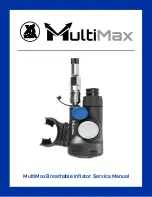
Bronkhorst®
Instruction Manual mini CORI-FLOW™ M1x
9.17.050O
28
3.10.2 Digital procedure
FlowPlot and FlowSuite provide an easy way to adjust the zero point of an instrument with RS-232 communication; the
Autozero
function automatically performs the procedure described here.
To adjust the zero point using digital communication, set parameter values in the following sequence (see section
for more information about instrument parameters):
Sequence #
Parameter
Value
Action
1
Setpoint
0
stop flow (close control valve)
2
Init Reset
64
unlock secured parameters
3
Control Mode
9
enable calibration mode
4
Calibration Mode
0
reset calibration mode
5
Calibration Mode
9
start zeroing
The green LED starts to blink fast, indicating that the zeroing procedure is being performed. On completion, the green LED
starts to glow continuously, while the output signal is 0% (parameter
Measure
= 0). At the same time, parameter
Control Mode
returns to its initial value. If the procedure is successful, parameter
Calibration Mode
changes to 0 (idle). If the procedure fails,
Calibration Mode
changes to 255.
After performing the procedure, remember to set parameter
Init Reset
to value 0 to lock secured parameters.
3.11
Checking calibration status
The calibration integrity of a mass flow meter for liquids can be verified in a relatively uncomplicated way by using an
accurate weighing scale, or by comparing it with another mass flow meter with a known calibration status as a reference.
This section describes a procedure for checking the calibration status with a weighing scale.
The
of the flow meter can be used to compare a batch with a configurable size (measured by the
instrument itself) to the (real) weight of the displaced liquid that is measured by an accurate weighing scale. To operate the
counter functionality, FlowPlot or a Bronkhorst® readout and control unit (E-8000, BRIGHT) can be used.
Apart from the instrument, the following items are needed for this calibration check:
·
an accurate weighing scale
·
a liquid container big enough to hold as much liquid as will get dosed in 2 minutes
·
a readout and control facility, e.g.:
o
a Windows computer with FlowDDE and FlowPlot installed
o
a Bronkhorst® readout and control unit
·
in case of a mass flow meter without control function: a shut off valve, to be installed downstream of the instrument
To perform a calibration check, follow these instructions:
1. Put the container on the weighing scale and tare it
2. Calculate the liquid mass that the instrument should measure in 2 minutes (based on a given setpoint or inlet pressure;
see further)
3. Configure the counter of the instrument to stop the flow as soon as the calculated mass is reached
4. Reset the counter
5. Make sure that the inlet pressure is stable and sufficient for proper control and a stable flow rate
6. Open the valve to fill the container:
a. controller: give a setpoint > 0%
b. meter: open the shut off valve
7. When the configured batch size is reached, compare the measured liquid mass to the mass indicated by the weighing
scale
When comparing both values, take the accuracy and the zero stability of the instrument into account: ± 0.2 RD (for liquids)
+ zero stability error (see
).
The procedure described here is by no means a proper calibration procedure; it can only be used to get a quick impression of
the calibration status of an instrument. Performing a reliable calibration procedure requires thorough knowledge of the
many parameters involved. Bronkhorst has skilled and experienced staff available that can take care of calibration matters;
contact your Bronkhorst representative for information.
















































